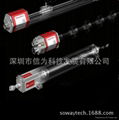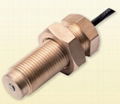| Model: | SDVH8B |
|---|---|
| Brand: | - |
| Origin: | Made In China |
| Category: | Electronics & Electricity / Other Electrical & Electronic |
| Label: | displacement sensor , LVDT , lvdt sensor |
| Price: |
-
|
| Min. Order: | - |
| Last Online:26 Feb, 2025 |
Introduction: The linear variable differential transformer (LVDT) is a position transducer that is noncontact, absolute reading, and has essentially infinite resolution. It comprises three or more coils within which a magnetically permeable core moves to provide variable coupling between the primary coil and the secondary coils (usually two). Although the detection technique is noncontact, there is often a mechanical arrangement added to keep the core positioned in the coil throughout the stroke. One example of this is the configuration called an LVDT gauge head. Practical linear sensors can be designed with a nonlinearity of less than 0.2% and full-scale ranges (FSRs) from less than 1 to over 100 mm. Resolution is nearly infinite. Curved and rotary sensors are possible. Popular applications include industrial machinery, such as metal forming machines and in-process dimensional verification, as well as automotive and commercial products. LVDTs require a set of driving and conditioning electronic circuits. A typical LVDT is sold as a sensing element with a core, the electronic circuit being supplied as a separate device. An LVDT that includes all the required electronics within its housing is often called a dc LVDT because it operates on a dc power supply and has a dc output, although the internal operation includes the normal ac driving, demodulation, and signal-conditioning circuitry.
Advantages:
1. Since the LVDT core does not touch the inside of the coil bobbin, it is a noncontact sensing element. This means that many full-stroke cycles can be endured without wear or degradation of the performance characteristics. In many applications, though, bearings are added to maintain the alignment between the core and the bore of the coil bobbin When bearing wear occurs, there is still no change to the LVDT accuracy, but there may be some additional force required from the measured element to drive the motion of the LVDT core.
2. An LVDT is an infinite-resolution sensor.
3. A hermetically sealed LVDT is a very r ed sensor.
Applications:
1. The LVDT is a popular choice for high-reliability military applications.They are often used as the position feedback sensor in the actuator for control surfaces in airplanes.
2. Incoming inspection tools use LVDTs to measure critical dimensions and read them into a computer that compares the data against the accepted tolerance.











